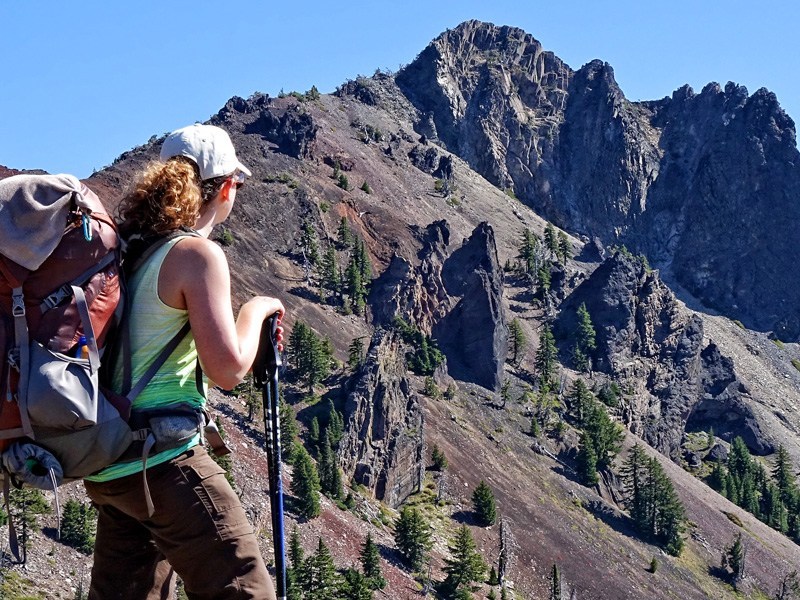In Spain there are more than 60,000 kilometres of approved paths, some more intense than others, through which we can enjoy nature while doing sport. For hiking it is advisable to follow some basic tips, such as knowing the signs, wearing appropriate clothing and footwear and providing our backpack with the basic elements.
Start hiking following these recommendations
Signaling
When choosing a route we must take into account our physical condition, choosing the routes with little unevenness and short distance at first and then go choosing trails with more difficulty.
Thus, depending on the
- Gran Recorrido (GR) trails are those trails that have more than 50 kilometres of route and are carried out in stages. The reference colour for this type of trails is red.
- The Small Route (PR) trails, marked in yellow, can be between 10 and 50 kilometers long, and can be done in one or two days depending on the distance and level of difficulty.
- The local trails (SL) are those whose travel is less than 10 kilometers and the difficulty is minimal, so they are suitable for children, elderly and people with physical difficulties. Their reference color is green.
However, not all trails are homologated and, therefore, the signage may be different.
Before starting the route
Before starting the activity, it is advisable to be well informed about the length of the path, the slope and the shelters nearby, as well as review the weather forecasts and review our team well not to forget anything essential.
It is also important that we inform a relative or somewhere about our itinerary in case it were necessary to locate us.
Equipment
The clothes we wear must always be breathable and suitable for each climate. It is best to use the new materials that protect against the cold while perspiring and that, due to their lightness, provide greater freedom of movement.
Even if it’s hot, it doesn’t hurt to carry some warm clothes in your backpack, as well as a raincoat. Socks should be made of

As far as footwear is concerned, it is ideal to wear lightweight, waterproof mountain boots that perfectly support the ankle and have a flexible, patterned sole. To avoid blisters, we must tie them tightly so that the foot does not dance inside the boot. It is also important to trim the nails well and not to wear the boots for the first time that same day.
Sports insurance
If you are going to move away from your place of residence to practise hiking or some other adventure sport, it is advisable to also equip yourself with a sports and travel insurance such as Totalsports which, in addition to guaranteeing you medical expenses or incidences of the trip related to the cancellation, luggage or transport, covers you against setbacks related to activities in nature.
Apart from accidents, Totalsports has guarantees such as search and rescue, diagnostic tests and rehabilitation treatments or the payment of prostheses or crutches, among others.
Backpack
When hiking, you have to dispense with non-essential elements, such as extra jars and clothes, as these will unnecessarily increase the weight of your load. Ideally, the objects we carry should be made of lightweight materials. Although it depends on the complexion of each person, the maximum weight of the hiker’s rucksack should be around 6 kilos.
However, we should not forget to always carry a map, a GPS or mobile phone, a headlamp, an elementary first aid kit (plasters, gauze, painkillers…), a raincoat if there is provision for rain, cream and sunglasses, and a pair of plastic bags for waste and food.
Wearing the right equipment will make our journey easier. A rucksack of a maximum of 30 litres equipped with a lumbar belt will help us to unload weight from the shoulders. To make it more comfortable, we must place the heaviest thing near the back and the clothes in the bottom, fitting the things like a puzzle so that they move less.
In this link you will find the essential elements to carry in your backpack to practice trekking.
On the road
Make sure that your pace is constant and regular, without changes of pace, always paying attention to the signage and taking care of nature respectfully. As you walk, breathe through your nose so that the air enters your body with the right temperature and humidity.
When resting, warm up well and hydrate yourself with water or an isotonic drink (carbonated drinks delay its absorption). To replace the amount of glucose and the loss of electrolytes, eat something that contains sugar, such as nuts, chocolate or sweets.
On climbs, take a short step, and on descents, control well where you put your foot. In many occasions the telescopic poles can help us to lower or to raise slopes, reducing in addition in up to 20% the load of the legs.
And after the route
You always have to rehydrate, bring salt, sugar and liquids to your body, and make a balanced meal; take care of your feet by healing and hydrating them; and, of course, have a good rest!


 Quality Leads in B2B Marketing
Quality Leads in B2B Marketing  Omega-3 and Brain Health
Omega-3 and Brain Health  Omega-3 and Eye Health
Omega-3 and Eye Health  Different Approaches to Medical Detoxification
Different Approaches to Medical Detoxification  Referral Code Marketing for SaaS
Referral Code Marketing for SaaS  Exploring the Latest Electrical Technologies
Exploring the Latest Electrical Technologies  Aspirin and Stroke Prevention
Aspirin and Stroke Prevention  Time to Invest in Gold
Time to Invest in Gold  The Impact of Gas Prices
The Impact of Gas Prices 